Antidiabetic and other Pharmacological Studies on Lucas inflata Benth
Mohammad Kamil*
Director General, Lotus Holistic Health Institute, UAE
Submission:April 14, 2023; Published:May 01, 2023
*Corresponding author: Mohammad Kamil, Director General, Lotus Holistic Health Institute, Abu Dhabi, UAE
How to cite this article: Mohammad Kamil. Antidiabetic and other Pharmacological Studies on Lucas inflata Benth. Curre Res Diabetes & Obes J 2023; 16(4): 555943. DOI:10.19080/CRDOJ.2023.16.555943
Abstract
Keywords: Antidiabetic; Hepatoprotective; Antipyretic; Anti-diarrheal; Hypoglycemic
Mini Review
The genus Leucas (family: Lamiaceae) is represented by over 116 members, which are broadly distributed throughout Asia, Africa, and India [1]. Members of this genus have been widely used as remedies in folk medicine in Africa and India for many diseases, and, thus, they have received considerable attention. Species, e.g., L. lavandulaefolia, have been described to have hepatoprotective, antipyretic, anti-diarrheal, hypoglycemic, antitussive, and wound healing activities [2-7]. Moreover, L. aspera was found to have antimicrobial, anti-inflammatory, antinociceptive, antioxidant, and cytotoxic activities [8-10]. L. martinicensis showed antibacterial, anthelmintic, and antimalarial activities [11-13]. Leucas inflata, the native range of this species is NE. Tropical Africa to Arabian Peninsula. It is a subshrub or shrub and grows primarily in the desert or dry shrubland biome (Figure 1).
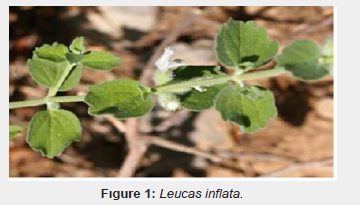
The plant is used in traditional medicine to cure many diseases such as cough, cold, diarrhea, and inflammatory skin disorders. A variety of phytoconstituents have been isolated from the Leucas species, which include lignans, flavonoids, coumarins, steroids, terpenes, fatty acids, and aliphatic long-chain compounds. Anti-inflammatory, analgesic, anti-diarrheal, antimicrobial, antioxidant, and insecticidal activities have been reported in the extracts of these plants and their phytoconstituents. An overview of the ethnobotanical, phytochemical, and pharmacological investigations on the Leucas species is presented in a big review [14]. The plants of the genus Leucas have been used by the tribals in various parts of Asia, Africa, and India.
The phytochemical work on the genus Leucas revealed the presence of variety of phytoconstituents like terpenoids, flavonoids, steroids, saponins, coumarins, fatty acids, tannins, and others from the acetone extract of the roots of Leucas inflata, four coumarins (siderin, coumarsabin, 8-methoxycoumarsabin and coumarleucasin) and one chromone were isolated. One of the coumarins, coumarleucasin (5-formyl-4,7,8-tri methoxy-3-methyl-coumarin), and the chromone, leucasone [(2,8-dimethyl (2,2-dimethyl ethenyl)-5,6-benzo-4-pyrone)], have not been reported previously [15]. The aerial parts of Leucas spp. also contain volatile oil, consisting of a variety of compounds. The analgesic activity of the methanol and acetone extracts of Leucas inflata L. (family Labiatae) was evaluated in mice using different experimental models [16]. Leucas species have been used in traditional medicine for various purposes, including treating fever, pain, inflammation, and respiratory disorders. Many species of Leucas have been found to possess pharmacological activities, such as antidiabetic, antimicrobial, antioxidant, analgesic, and anti-inflammatory properties. Some species have also been shown to have antitumor and neuroprotective effects. In the present study, different pharmacological activities of the genus Leucas inflata are dealt to verify its medicinal values (Table 1-10) & Figure 2).
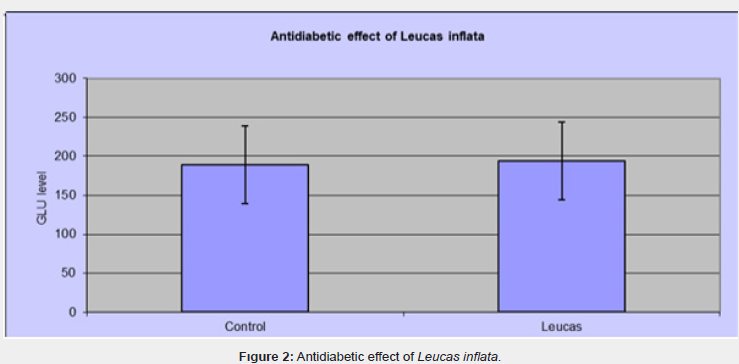
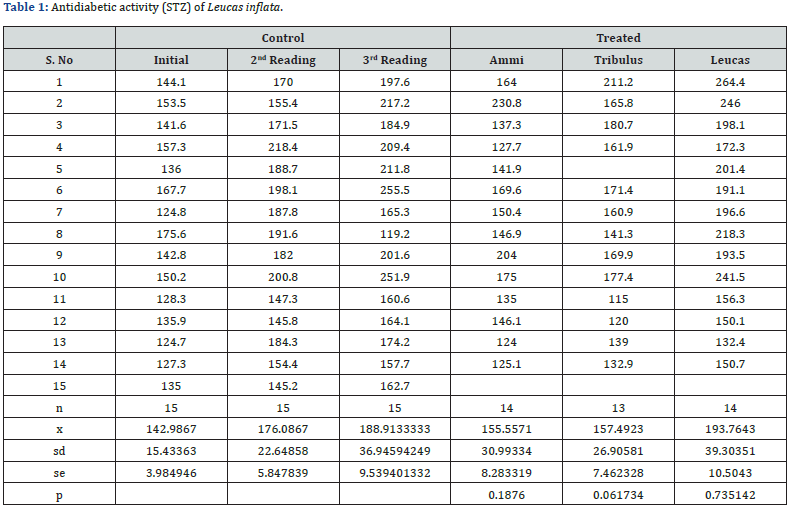
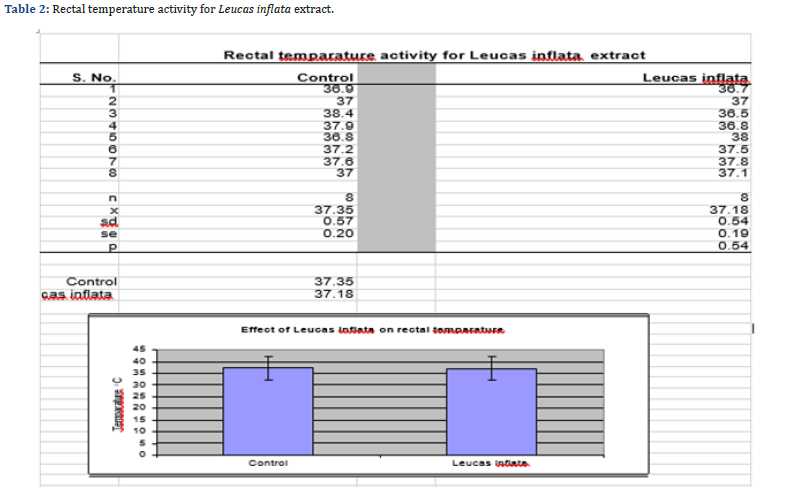
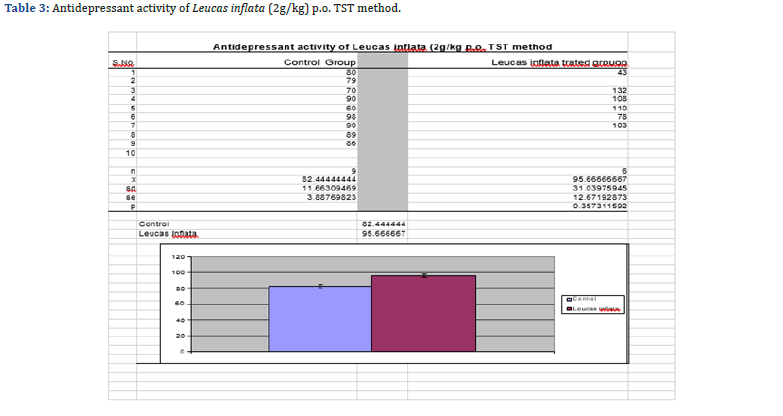
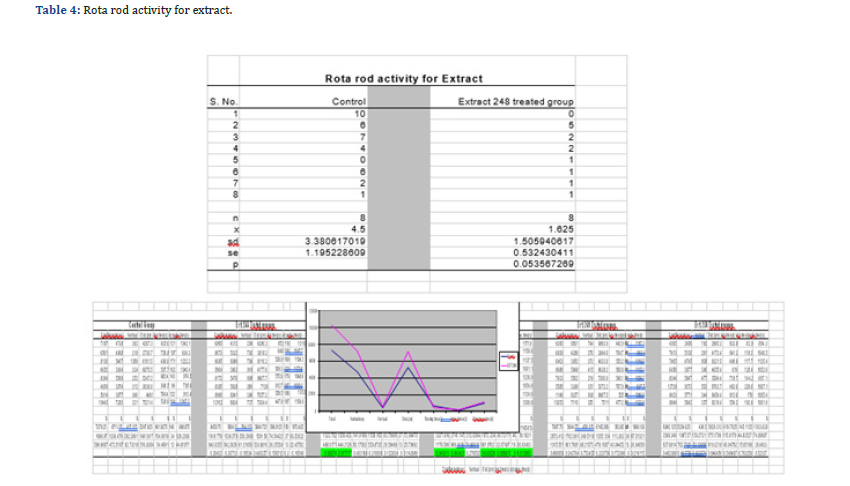
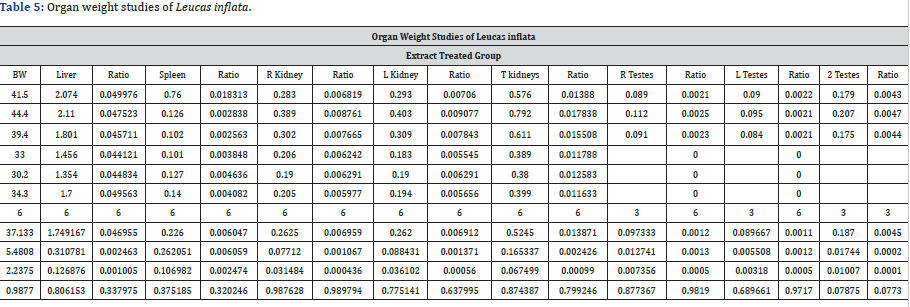
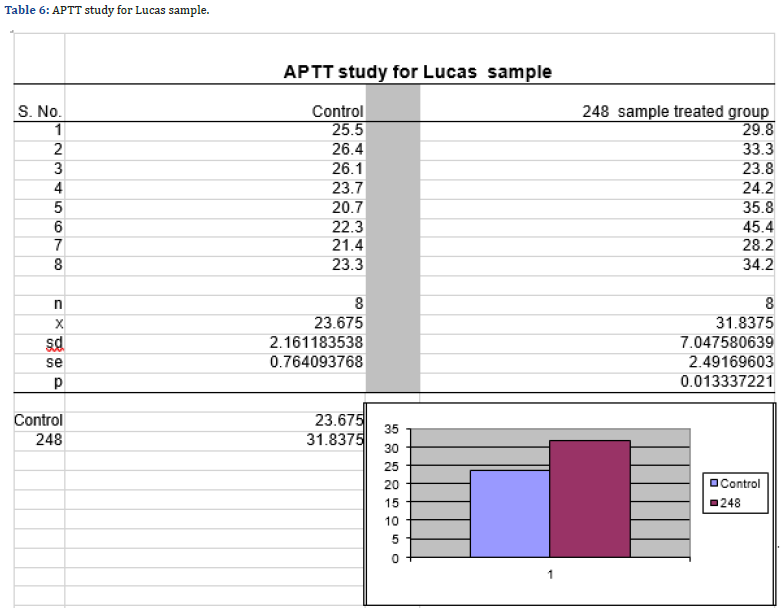
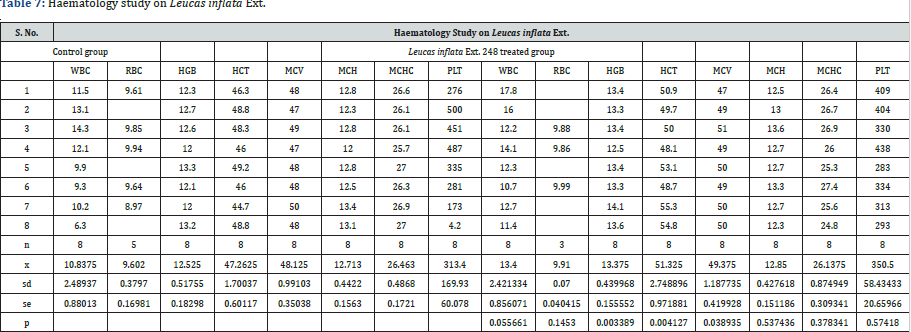
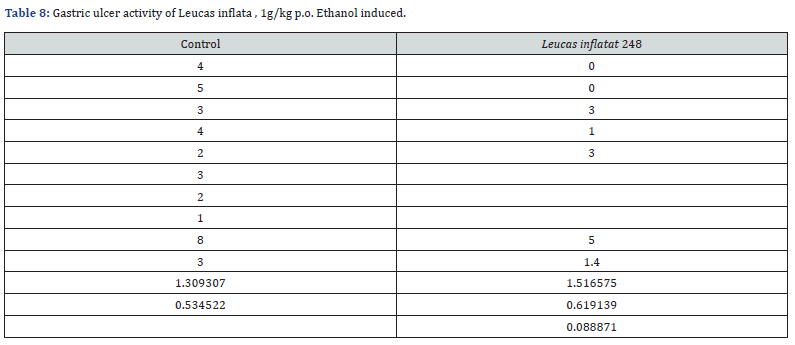
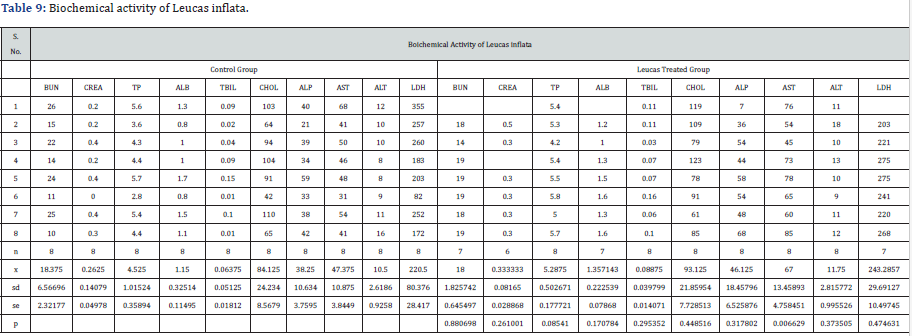
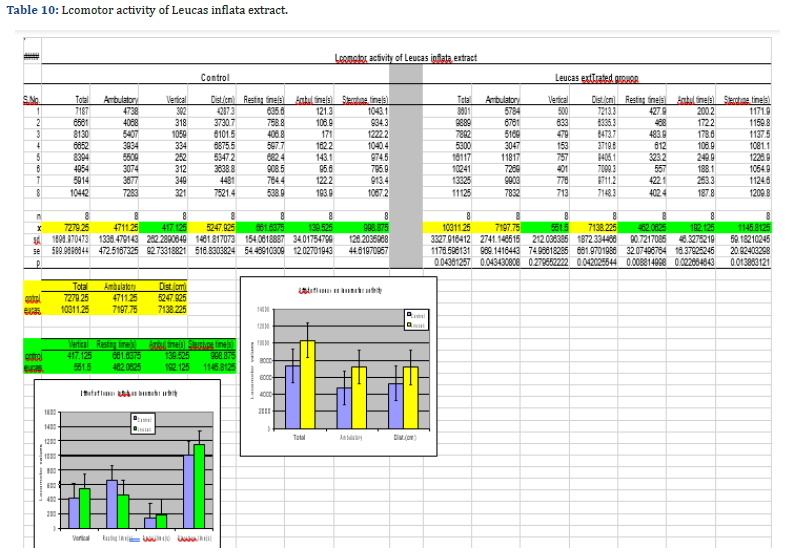
Evaluation of Anti-Diabetic Activity in STZ Diabetic mice
The hypoglycaemic activity of the plant extract in mice made diabetic by streptozotocin (STZ) was investigated. The plant extract administered at doses of 1g/g/kg daily for 7 days failed to reduce blood glucose levels in STZ induced diabetic mice as compared to the control group. The present study clearly shows that the oral administration of plant extract did not possess significant antihyperglycemic activity.
Effect of Plant Extract on the Guinea-Pig Isolated Ileum
A male guineapig is killed by a blow on the head and exsanguinated. The abdomen is opened and the caecum is lifted. A part of the ileum, attached to the rear of the caecum, is removed, placed in a dish and covered with modified Tyrode solution. The mesentery was trimmed away and the ileum is cut into pieces of 2 - 3cm (in relaxed condition). A thread is attached to each end of the piece of ileum by inserting a needle from the inside of the ileum to the outside. The piece of ileum is firmed in a vertical position in a 10ml organ bath filled with modified Tyrode solution, kept at 37°C, and bubbled through with oxygen/carbon dioxide (95% O2 + 5% CO2).
One end is tied to a fixed pin and the other one to an isotonic transducer loaded with 1g. The ileum preparation is equilibrated in the bath fluid for at least 10 minutes to stabilize the baseline value. Every 5 minutes it is washed. All washes consist of 3 replacements of bath fluid.
Extract of Leucas inflata L., given at single oral doses of 0.25, 0.5, 1.0, or 2.0g/kg, significantly and dose-dependently, reduced formal in induced pain, acetic acid-induced abdominal constrictions and increased the reaction time in the hot-plate test. The extract caused significant and dose-related impairment in the sensorimotor control and ambulatory and total motor activity of treated mice. Both extracts exhibited anti-inflammatory action by reducing paw edema of treated mice. The extracts did not significantly affect the rectal
temperature of normothermic mice. However, it was effective in preventing Brewer’s yeast-induced pyrexia. It is concluded that the extract of Leucas inflata has CNS depressant properties, manifested as antinociception and sedation. The extract has anti-inflammatory and antipyretic actions.
The analgesic activity of the extract of Leucas inflata was evaluated in mice using different experimental models. The effect of the two extracts on pentobarbitone-sleeping time, motor activi ty, sensorimotor coordination, carrageen-induced inflammation, and brewer’s yeast-induced pyrexia has also been investigated. The crude extract has been phytochemically analyzed and some constituents isolated and characterized. These included stigmasterol’s, chromone, and coumarins. Extract of Leucas inflata, given at single oral doses of 0.25, 0.5, 1.0 or 2.0g/kg, significantly and dose-dependently, reduced formalin-induced pain, acetic acid-induced abdominal constrictions and increased the reaction time in the hot-plate test. Both extracts caused significant and dose-related impairment in the sensorimotor control and ambulatory and total motor activity of treated mice. The extract exhibited anti- inflammatory action by reducing paw edema of treated mice. The extract did not significantly affect the rectal temperature of normothermic mice. However, it was effective in preventing Brewer’s yeast-induced pyrexia. It is concluded that the crude extract of Leucas inflata has CNS depressant properties, manifested as antinociception and sedation. The extract has anti-inflammatory and antipyretic actions.
The results of the experiments indicate that plant extract, tested at concentrations of 100mg/ml actively reduced the guinea pig ileum contractions. The extract caused significant and dose-related impairment in the sensorimotor control and ambulatory and total motor activity of treated mice.
These findings are of interest in regard to the medical uses of Leucas inflata as an herbal drug for the spasmolytic effect. The presence of relaxation/ antispasmodic activity showed antidiarrheal/ antisecretory activity. It might produce relief of gastrointestinal spasms and improve digestion.
References
- Hedge I, Nasir Y, Ali S (1990) Flora of Pakistan. University of Karachi, Department of Botany: Karachi, Pakistan, pp. 192.
- Chandrashekar K, Prasanna K, Joshi A (2007) Hepatoprotective activity of the Leucas lavandulaefolia on D (+)galactosamine-induced hepatic injury in rats. Fitoterapia 78(6): 440-442.
- Mukherjee K, Saha B, Mukherjee PK (2002) Evaluation of antipyretic potential of Leucas lavandulaefolia (Labiatae) aerial part extract. Phytother Res 16(7): 686-688.
- Mukherjee PK, Saha K, Murugesan T, Mandal S, Pal M, et al. (1998) Screening of anti-diarrhoeal profile of some plant extracts of a specific region of West Bengal, India. J Ethnopharmacol 60(1): 85-89.
- Saha K, Mukherjee PK, Das J, Mandal SC, Pal M, et al. (1997) Hypoglycaemic activity of Leucas lavandulaefolia in streptozotocin-induced diabetic rats. Phytother Res 11(6): 463-466.
- Saha K, Mukherjee PK, Murugesan T, Saha B, Pal M (1997) Studies on in vivo antitussive activity of Leucas lavandulaefolia using a cough model induced by sulfur dioxide gas in mice. J Ethnopharmacol 57(2): 89-92.
- Saha K, Mukherjee PK, Das J, Pal M, Saha B (1997) Wound healing activity of Leucas lavandulaefolia J Ethnopharmacol 56(2): 139-144.
- Mangathayaru K, Lakshmikant J, Sundar NS, Swapna R, Grace XF, et al. (2005) Antimicrobial activity of Leucas aspera Fitoterapia 76(7-8): 752-754.
- Goudgaon N, Basavaraj N, Vijayalaxmi A (2003) Anti-inflammatory activity of different fractions of Leucas aspera Indian J Pharmacol 35: 397-398.
- Rahman M, Sadhu S, Hasan C (2007) Preliminary antinociceptive, antioxidant and cytotoxic activities of Leucas aspera Fitoterapia 78(7-8): 552-555.
- Ashokkumar S, Ravi S, Kathiravan V, Velmurugan S (2014) Rapid biological synthesis of silver nanoparticles using Leucas martinicensis leaf extract for catalytic and antibacterial activity. Environ Sci Pollut Res Int 21(19): 11439-11446.
- Eguale T, Tadesse D, Giday M (2011) In vitro anthelmintic activity of crude extracts of five medicinal plants against egg-hatching and larval development of Haemonchus contortus. J Ethnopharmacol 137(1): 108-113.
- Asase A, Oteng-Yeboah AA, Odamtten GT, Simmonds MS (2005) Ethnobotanical study of some Ghanaian anti-malarial plants. J. Ethnopharmacol 99: 273-279.
- Surya Narayan Das, Varanasi Jaganath Patro, Subas Chandra Dinda (2012) Ethnobotanical survey of genus Leucas, PHCOG Review.
- Al Yousuf MH, Bashir AK, Blunden G, Yang MH (1999) Coumarleucasin and leucasone from Leucas inflata Phytochemistry 51(1): 95-98.
- M H Al-Yousuf, B H Ali, A K Bashir, M O M Tanira, G Blunden (2002) Central nervous system activity of Leucas inflata in mice. Phytomedicine 9(6): 501-507.






























